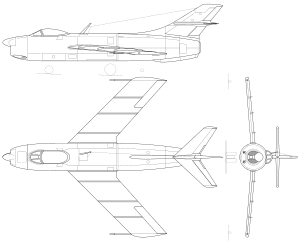| Yak-50 | |
|---|---|
| Role | Fighter interceptor |
| Manufacturer | Yakovlev |
| First flight | 15 July 1949 |
| Status | Cancelled |
| Primary user | Soviet Air Forces |

Yakovlev Yak-50
Yakovlev Yak-50 was an early experimental turbojet interceptor aircraft designed in 1948 by the Yakovlev OKB in USSR. The aircraft was essentially a stretched version of the Yakovlev Yak-30 (1948), with a more powerful engine and greater sweep to the wings. The Yak-50 is perhaps most significant as the first Yakovlev aircraft equipped with the velosipednoye (bicycle) landing gear, a trademark of later Yakovlev designs. The Yak-50 designation was later reused for a propeller-driven aerobatic and trainer aircraft.[1]
Development and design[]
On February 21, 1949 a Sovmin order requested the Yakovlev OKB to design a lightweight, radar-equipped, all-weather and night interceptor capable of Mach 0.97 at 4,000 m (13,000 ft). The aircraft was to utilize the Klimov VK-1 engine which first appeared on Mikoyan-Gurevich MiG-15 and MiG-17 fighters. This engine was itself a Soviet copy of the British Rolls-Royce Nene centrifugal turbojet initially known as the RD-45. The leading fighter OKBs each created a prototype to meet the requirement, which included the Lavochkin La-200, Mig I-320, Suchoi Su-15 (unrelated to the later aircraft with the same designation) and the Yak-50 (again, unrelated to the later aircraft). A major difference was that while Yakolev used one engine, the other design bureaus used two.[1]
Testing[]
The aircraft first flew on 15 July 1949,[1] with test pilot Anokhin achieving supersonic speed (Mach 1.03 at 10,000 m (33,000 ft)) in a shallow dive during one of the test flights. Ultimately, none of the newly developed aircraft was selected, and an upgraded MiG-17 was eventually employed. Yakolev later used the velosipednoye landing gear in the Yak-140 fighter and the Yak-120, and later in the Yak-25 and Yak-28 where it proved highly successful.[1]
The Yak-50 never received an ASCC name or USAF reporting number.[1]
Operators[]
Specifications[]
General characteristics
- Crew: 1
- Length: 11.12 m (36 ft 6 in)
- Wingspan: 8.01 m (26 ft 3 in)
- Height: ()
- Wing area: 16.0 m² (172.2 ft²)
- Empty weight: 3,085 kg (6,787 lb)
- Loaded weight: 4,155 kg (9,141 lb)
- Powerplant: 1 × Klimov VK-1 centrifugal compressor turbojet engine, 26.5 kN (5,940 lbf)
Performance
- Maximum speed: 1,120 km/h (696 mph)
- Range: 850 km (528 mi)
- Service ceiling: 16,050 m (52,600 ft)
- Rate of climb: 68 m/s (13,400 ft/min)
- Wing loading: 260 kg/m² (53 lb/ft²)
- Thrust/weight: 0.65
Armament
See also[]
- Yakovlev Yak-30 (1948)
- Yakolev Yak-140
- Mikoyan-Gurevich MiG-17
- F-94 Starfire
- F-86D
- Dassault Mystère II
- Dassault Mystère IV
- List of military aircraft of the Soviet Union and the CIS
References[]
- Gunston, Bill. Yakovlev Aircraft since 1924. London, UK: Putnam Aeronautical Books, 1997. ISBN 1-55750-978-6.
External links[]
| Wikimedia Commons has media related to Yakovlev aircraft. |
The original article can be found at Yakovlev Yak-50 (1949) and the edit history here.